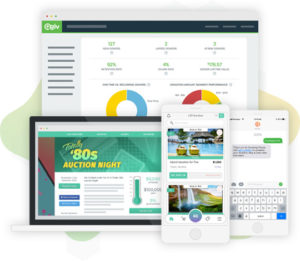 There’s no doubt about it: peer to peer fundraising is here to stay.
There’s no doubt about it: peer to peer fundraising is here to stay.
Nonprofits of all sizes and causes have been able to soar to new fundraising heights thanks to the magic of peer to peer (or P2P) fundraising campaigns. In addition to supercharging their fundraising potential, P2P also gives nonprofits the added benefits of boosted supporter engagement, community awareness, and fast, free marketing for their cause.
So what exactly is peer to peer fundraising, and how can you capitalize on it at your own organization? Let’s discuss.
Peer to peer fundraising is a nonprofit strategy that empowers supporters to become fundraisers on behalf of the organization they’re supporting. Donors set up individual fundraising pages and solicit donations from their networks, typically through online communication methods such as social media and email.
Best of all? Peer to peer fundraising isn’t that complicated. In fact, your nonprofit can maximize your P2P potential by following just 5 simple steps:
- Power your peer to peer fundraising with technology.
- Establish smart peer to peer fundraising goals.
- Set a clear peer to peer campaign timeline.
- Think outside the box for your peer to peer event.
- Educate (and motivate!) your fundraisers.
We’ll dive into each of these tips in great detail, so keep reading to push your P2P fundraiser to the next level. Or, refresh your memory on the basics of peer to peer fundraising first by checking out this guide from the fundraising experts at BidPal.
1. Power your peer to peer fundraising with technology.
 In today’s nonprofit world, there’s software for virtually everything, and peer to peer fundraising campaigns are certainly no exception. In fact, without peer to peer fundraising software, these campaigns wouldn’t even be possible!
In today’s nonprofit world, there’s software for virtually everything, and peer to peer fundraising campaigns are certainly no exception. In fact, without peer to peer fundraising software, these campaigns wouldn’t even be possible!
P2P software gives your organization the ability to:
- Build a branded campaign page for your nonprofit.
- Allow supporters to create and customize their own fundraising pages.
- Accept donations online.
- Collect, store, and manage donor data.
- Register guests for your peer-to-peer fundraising event.
- Track campaign progress and create multifaceted peer to peer fundraising reports.
Peer to peer fundraising software (which can exist as a feature of your comprehensive CRM or as a standalone online fundraising platform) should be the baseline for your upcoming campaign. If you want to make the most of your P2P campaign, though, you should enlist the help of other types of nonprofit software too.
For example, you might use:
- Text-to-give software to accept mobile donations throughout your campaign and onsite at your fundraising event.
- Giving kiosks to process credit or debit card donations at your event (or as part of a concurrent checkout charity initiative).
- Nonprofit marketing software to get the word out about your campaign in the most effective ways.
Not only can the right technology solutions make giving more convenient for donors, but they’ll also streamline the data management process for your nonprofit. Having the tools to personalize outreach and create richer donor profiles, leaves you with more time to focus on other (more fun!) aspects of your campaign.
The bottom line: Innovative technology can be your nonprofit’s new best friend during your peer to peer fundraiser. You’ll need P2P fundraising software to start, but you can enhance your outreach by implementing other technology as well.
2. Establish smart peer to peer fundraising goals.
As with any fundraising campaign, you can’t expect to succeed in your peer to peer efforts without a well-thought-out strategy.
To nail down your plan, we recommend first answering the following questions:
- Where does peer to peer fundraising fit in with our overall goals? Because P2P campaigns are typically time-sensitive, it’s best to use them to fund a specific, concrete project. While they might be part of your annual campaign, you should tie your peer to peer fundraisers to a short-term project for best results.
- How much money can we feasibly raise? (And how much do we need to spend to make it happen?) Subtract any funds you’ll need to spend on software, a fundraising consultant, or event logistics to determine a reasonable, yet ambitious, monetary goal for your campaign.
- How many fundraisers can we expect? You may have a handful of high-reaching fundraisers, but more likely, you’ll need a lot of supporters each raising a moderate amount of money through their individual campaigns. Make sure your goal reflects the number of fundraisers you’re likely to engage.
- How many new donors do we hope to acquire? Because your fundraisers will be soliciting their own networks, you’ll come into contact with a lot of new faces throughout your P2P campaign. Set a tangible goal for how many new supporters you hope to attract so that you can target your marketing efforts appropriately.
No matter what goals you set, make sure that each of them are as measurable as possible. With financial goals, this won’t be hard; you simply choose your lucky number and track your progress against it!
With other, more abstract goals (such as supporter engagement), measuring success can be tricky. We suggest breaking out those main goals into easily quantifiable “subgoals.”
For example, if community awareness is your main goal, you might track first-time donations, social media impressions and engagements, and first-time event attendees as subgoals.
Want more insight into fundraising planning? Take a look at Aly Sterling Philanthropy’s guide to developing a fundraising strategy (plus their trusty template).
The bottom line: Setting goals for your peer to peer fundraising campaign makes it easier to assess your success later on. Determine key main goals as well as secondary subgoals to stay on top of your progress across the board.
3. Set a clear peer to peer campaign timeline.

After establishing your campaign goals, you’ll want to start putting mechanics in motion by developing a campaign calendar.
The primary purpose of a campaign timeline is, of course, to set a start and end date for your campaign. If you’re hosting an event in conjunction with your P2P fundraiser (and we suggest that you do!), you’ll need to pick out a date and time for that to take place as well.
But in addition to those most necessary details, your calendar can also serve as a jumping off point for considering other important elements of the campaign, such as:
- Campaign length. As you select your time frame, you’ll need to put some thought into the length of your fundraiser. While you need to provide ample time for fundraisers to reach their individual goals, you’ll also want to promote a sense of urgency by keeping the fundraising window short.
- Time of year. Supporters tend to be in the giving mood around the holidays, but outdoor peer-to-peer events aren’t going to be much fun in the dead of winter (if you’re in a cold climate, especially). Each season has its own fundraising benefits and drawbacks, so make sure your campaign still works well with those pros and cons in mind.
- Communication schedule. You shouldn’t flood your fundraisers with dozens of emails per day (or even week), so avoid that possibility by mapping out your communication schedule well in advance. Consider the content you’ll send to donors, the medium, and the frequency as you plan your calendar.
You might also want to add in fundraising or engagement benchmarks throughout your campaign as you plan your timeline. Making a point to set small goals now can help you measure your progress better once you’re in the thick of the campaign.
For example, how many fundraisers do you want to have recruited by day 10 of your campaign? How much money do you hope to have raised by the midway point?
The bottom line: Plan out a campaign calendar that encompasses the start and end date for your fundraiser, an appropriate event date, and a roadmap for your communications plan. Don’t forget to outline your goals along the way!
4. Think outside the box for your peer to peer event.
As P2P fundraising becomes more ubiquitous, donors become more familiar with the typical structure of these campaigns and their corresponding events.
Familiarity can be a good thing since you won’t have to spend too much time explaining how your fundraiser will work. But too much familiarity can also mean that you’ll run the risk of getting lost in the shuffle of all the peer-to-peer fundraisers your supporters might already be involved in.
A great way to stand out from the crowd is to take a creative approach to your peer to peer fundraising event!
We know event-planning can be a tough task, so we’ll make it easier by letting you in on some of our favorite event strategies that are both simple and game-changing:
 Add a competitive edge. Races, walkathons, and other active events are popular choices for peer-to-peer campaigns because they’re naturally communal and engaging. Turn yours up a notch by teasing exciting prizes to top competitors!
Add a competitive edge. Races, walkathons, and other active events are popular choices for peer-to-peer campaigns because they’re naturally communal and engaging. Turn yours up a notch by teasing exciting prizes to top competitors!- Throw in a theme. Mixing in a fun theme can take an event from boring to anything-but. Consider theming your event around your cause! For example, animal welfare organizations can quickly attract guests by telling them to bring their furry friends to a 5K.
- Let your donors take the reins. If planning an event doesn’t seem feasible, you can still reap all the benefits by letting your supporters “donate” a special event in their lives, like a wedding day or birthday. See if your software will let you build a custom peer-to-peer fundraising options to make use of this profitable (and popular!) strategy.
At any event, you’ll find that it’s not the decor, venue, or entertainment that matters—it’s celebrating your fundraisers’ success in raising money for your campaign! Highlight top donors and thank your guests for their hard work. Without them, your nonprofit’s progress wouldn’t be possible.
The bottom line: Use your event as an opportunity to showcase your creativity. No matter what, have fun at your peer to peer event and illustrate your gratitude for your donors’ involvement throughout the campaign.
5. Educate (and motivate!) your supporters.
When it comes down to it, your peer to peer fundraiser’s success rests on your supporters’ shoulders.
Don’t believe us? Think about just a few of the things that your constituents are responsible for throughout the duration of your campaign:
- Soliciting donations from their peers.
- Advertising your campaign on social media, via email, and face-to-face.
- Attending and volunteering at your event.
- Introducing your nonprofit to potential new donors and educating their communities on your cause.
Though your supporters will be taking the lead on many aspects of your fundraiser, your nonprofit still has a vital role to play in the fate of your campaign.
It’s up to your team to equip your fundraisers with all of the tools they need to raise money (and awareness) for your mission, and to inspire them to get out there and get to it!
To make sure your fundraisers feel empowered throughout every step of the campaign, follow these steps:
- Provide resources, such as donation solicitation templates, social media and email scripts, and plenty of educational documents explaining your campaign and your nonprofit’s cause.
- Present a united front by creating well-branded materials such as social media graphics, videos, infographics, and more. Make sure these are easy to access on your website so donors can quickly download them to share on their own pages.
- Prioritize gratitude in a variety of ways. Thank donors individually for every donation, but also send notes of appreciation to fundraisers when they hit their goal or go above and beyond. Social media, email, and even phone calls can remind supporters that their effort hasn’t gone unnoticed.
While you want to give your fundraisers the autonomy to lead their campaigns their own way, remember to stay hands-on throughout the fundraiser.
The bottom line: By being involved in your campaign, you’ll show fundraisers that you’re right by their side and can’t wait to see how they push your mission forward. Don’t forget to offer support whenever possible and interact with your fundraisers online and at your event.
Peer-to-peer fundraising campaigns are always an exciting endeavor for nonprofits. Keep these 5 steps in mind, and you’ll be well on your way to starting your own peer-to-peer movement.
Happy fundraising!
About the author:

 Abby Jarvis is a blogger, marketer, and communications coordinator for Qgiv, an online fundraising service provider. Qgiv offers industry-leading online giving and peer to peer fundraising tools for nonprofit, faith-based, and political organizations of all sizes. When she’s not working at Qgiv, Abby can usually be found writing for local magazines, catching up on her favorite blogs, or binge-watching sci-fi shows on Netflix.
Abby Jarvis is a blogger, marketer, and communications coordinator for Qgiv, an online fundraising service provider. Qgiv offers industry-leading online giving and peer to peer fundraising tools for nonprofit, faith-based, and political organizations of all sizes. When she’s not working at Qgiv, Abby can usually be found writing for local magazines, catching up on her favorite blogs, or binge-watching sci-fi shows on Netflix.






Leave A Comment